#a burial at ornans
Photo

A Burial At Ornans by Gustave Courbet - 1849
8 notes
·
View notes
Text
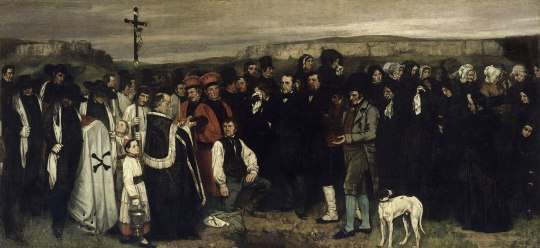
The painting records a funeral in Courbet's birthplace, the small town of Ornans. It treats an ordinary, provincial funeral with frank realism, and on the grand scale traditionally reserved for the heroic or religious scenes of history painting. Its exhibition at the 1850–51 Paris Salon created an "explosive reaction" and brought Courbet instant fame. The provocative presentation of an ordinary subject in a large format has led many commentators to see the work as a political statement.
Other commentators have rejected both politics and class as key to the painting's meaning. Some have simply interpreted it as Courbet's effort to depict an event that took place in his hometown. The art critic Champfleury wrote at the time, "there is not a trace of socialism in A Burial at Ornans ... Fortunately, M. Courbet has not tried to prove anything by his Burial. It represents death of a citizen who is escorted to his last resting place by other citizens ... It has pleased the painter to show us the domestic life of a small town ... As to the alleged ugliness of the townspeople, there is nothing exaggerated about it."
0 notes
Text
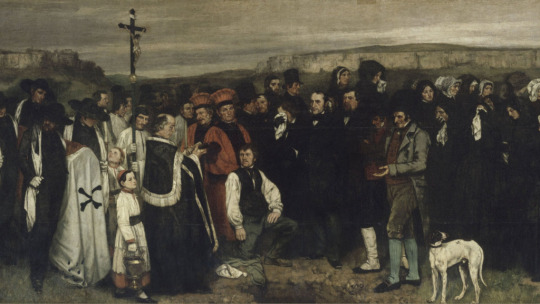
A BURIAL AT ORNANS (1850) by GUSTAVE COURBET
The image is unflattering, but it is dignified. There is peace and tranquillity in what we see in front of us. There is not an attempt to magnify the scene with a grandiloquent image of descending ANGELS and GOD sitting on a throne above the clouds.
In the foreground, an open grave is waiting for the coffin. The funeral procession is approaching from the left, and in the procession, we can see the pallbearers walking slowly behind the priest and the altar boys, as they approach the open grave and the grave digger on his knees at the head of the grave.
As for the mourners, what’s interesting about this scene is that COURBET didn’t use models for the mourners. This would normally be the case with historical narrative paintings, but COURBET wanted to be realistic, so he used real villagers who were present at the ceremony. This included his sister and his mother.
In the right foreground, we can see the face of a little girl peeking out from the grave. We only see her face. The rest of her body is almost obscured by a mass of black clothing. COURBET keeps the heads of mourners with the top of the cliff and the ground in the background.
It seemed to the critics that the histrionic and over-the-top expressions of grief that they were accustomed to seeing in the great historical funeral pictures of the past were missing in this painting. They thought it was ugly and that it probably overlooked the angels and the image of GOD sitting on the throne, waiting for someone new to enter his kingdom.
1 note
·
View note
Text
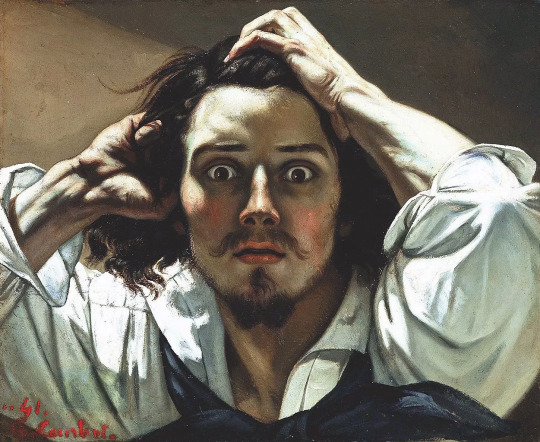
The famously overwrought self-portrait The Desperate Man (1843–45) by the French Realist Gustave Courbet remained in the artist’s studio until his death. In the modestly sized painting, the 24-year-old stares wild-eyed out at the viewer, his hands tearing at his flowing, unkempt hair. In his blousy white shirt and blue smock, Courbet here appears the quintessential Romantic artist—a tortured genius struggling for recognition and a bite to eat.
While familiar in this folkloric sense, The Desperate Man contrasts markedly with the public image Courbet had been steadily crafting for himself. Only a few years later, at the Paris salon of 1850–51, he would cause a sensation with confrontational canvases—The Stonebreakers (1849–50, since destroyed) and A Burial at Ornans (1849–50) among them—featuring ordinary people from his native Ornans depicted at a large scale typically reserved for lofty history painting.
The unvarnished realism of these works would establish Courbet as the proponent of a new art, one that reflected life—including the lower classes—as it is. “To know in order to do, that was my idea,” the artist wrote in 1855. “To be in a position to translate the customs, the ideas, the appearance of my time, according to my own estimation; to be not only a painter, but a man as well; in short, to create living art—this is my goal.”
38 notes
·
View notes
Text

Disembowelment - Dusk & Deep Sensory Procession Into Aural Fate (Compilation) [April 24th, 2020]
Country: Australia
Genre: Funeral Doom/Death Metal
Reuploaded: FLAC
Lineup:
Renato Gallina - Vocals, Guitars
Jason Kells - Guitars, Bass (Tracks 4 - 7)
Matthew Skarajew - Bass (Tracks 1 - 3)
Paul Mazziotta - Drums
Label: Relapse Records
Tracklist:
The Tree of Life and Death - 09:21
A Burial at Ornans - 12:03
Cerulean Transience of All My Imagined Shores - 08:29
River of Salvation - My Divine Punishment - 03:30
River of Salvation - The Tree of Life and Death - 08:42
A Burial at Ornans - 12:32
As Your Soul Befalls - 00:41
#Hermit's Lair#Human Antithesis#Telegram#Disembowelment#Funeral Doom Metal#Doom Metal#Death Metal#Renato Gallina#Jason Kells#Matthew Skarajew#Paul Mazziotta#Australia#Relapse Records#USA#US#United States
0 notes
Text
Post #1: On Experiencing Art Museums
In Paris there are many historical and beautiful museums all around the city that represent the important history and changes France went through to get to where it is today. As I have been able to visit many of these beautiful museums such as the Louvre, Carnavalet, d’Orsay, and l'Orangerie, my overall experience has been even more amazing than what I had hoped for. I especially have enjoyed being able to have learned some of the history so when I go to these beautiful museums I actually understand what the paintings are depicting, such as Napoleon crowning his wife or Marat dead in his bathtub, which allows me to have a better appreciation and understanding of them. I especially loved and have enjoyed learning about the realism period in art so when we went to Musee d’Orsay I was blown away by all the beautiful paintings all around me. One of my favorites there was The Burial at Ornans by Gustave Courbet. Courbet was a very prominent realism painter and really helped shape this period. Courbet, like all other realism artists, really wants to focus on truth and sincerity in art, which I think Courbet does beautifully in The Burial at Ornans. I really love how in Courbet and other realism pieces you can see the hand of the painter in the canvas as it adds so much texture and dimensionalism. I am also a big nature and mountain and realistic person so I enjoy this time period for its call back to nature, truth, and just plain old everyday life. Courbet I believe does a beautiful job with this by emphasizing ordinary in an extraordinary way especially in his huge piece, The Burial at Ornans. With his use of color he was really able to express this sad feeling in the painting, even if you did not know what the painting was trying to tell you, his use of dark colors such as, gray for the sky or black for the peoples clothing, really do a good job at telling us how we should feel when looking at this piece. The movement of the piece is also interesting as there really is no central figure but rather two sides that your eyes move to, as the people are more prominently seen on both sides of this huge piece. There is also a lot of variety in this piece, almost to the point that you miss some of the key pieces such as, the coffin on the left of the painting and the hole on the bottom middle part of the piece. However, after noticing these two pieces the image becomes very clear at what Courbet is depicting, which is a funeral. I think what interested me the most about this painting is all of the questions that came to my mind when I was looking at this piece. As I took a moment to truly understand what was going on in the painting I wondered who the person being buried was? Were they of importance? Was it a man or woman? Where were they from? How old were they when they died? And lastly the one that still tugs at my brain now is what if the burial is representing the person looking at the piece? What if Courbet wants to show from a heavenly perspective what your own funeral could look like? All these questions truly connected me to the piece in a way that is almost hard to describe but at the same time so easy to understand. Which I believe is the reason I love the piece so much!
Being able to better understand how to really look at art and understand what I am looking at has given me a way better understanding and more importantly a bigger appreciation for the pieces so many people have created. The history behind the pieces and the painters helps add a deeper understanding as well to the pieces which is really amazing and makes me feel like a true art connoisseur.
Word count: 673
First image below is image I took of The Burial at Ornans, Second is found from the web so you can see it better!

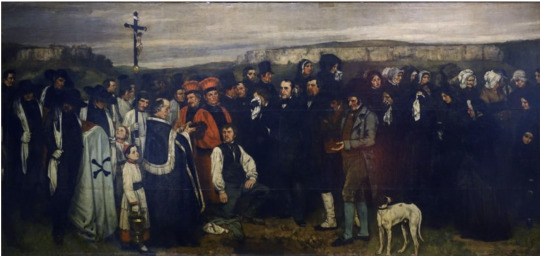
1 note
·
View note
Text
30th of April 2022
TO DO LIST
Classical Greek Mythology Reading Journal
○ Research Bacchae
○ Watch 25th of April Lecture
○ Write essay
Art History Week 1
● 31st of March Lecture
Art History Week 2
● 5th of April Lecture
○ 7th of April Lecture
○ ���A Description of ‘Work’“
○ “Ford Madox Brown”
○ “The Rhetoric of Realism”
○ “Art Cannot be Taught”
○ “On Courbet’s Stone Breakers & Burial at Ornans”
○ “The Realist Manifesto”
Art History Week 4
○ “The New Painting”
○ “Modern Practices of Art and Modernity”
○ “Canvases and Careers: Institutional Change in the French Painting World“
○ “Gender and Representation”
0 notes
Photo
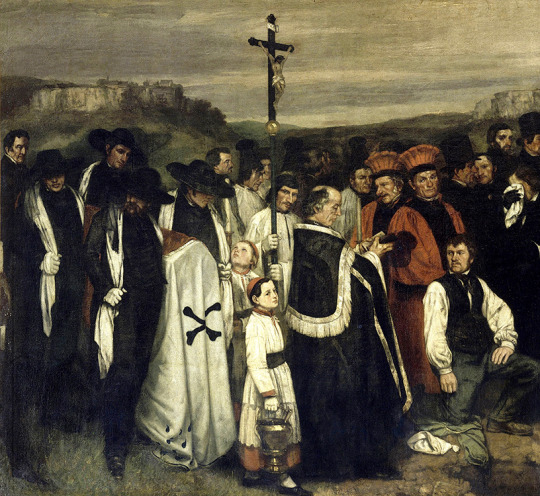

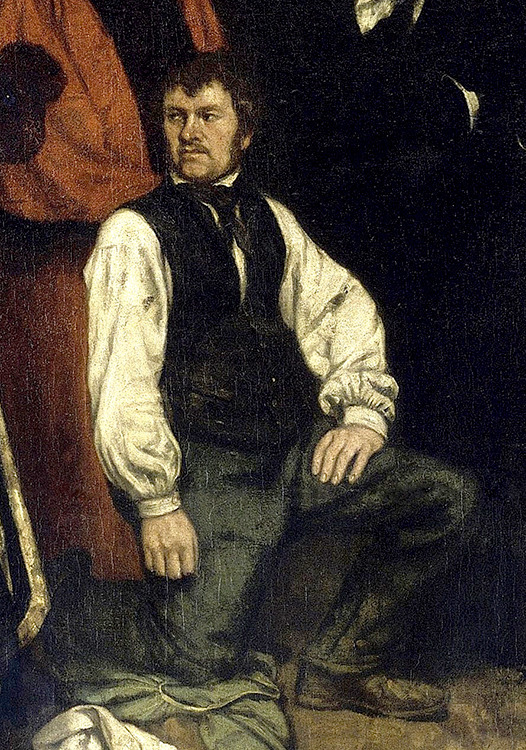
A Burial At Ornans, (1849-50) - Gustave Courbet
1 note
·
View note
Photo
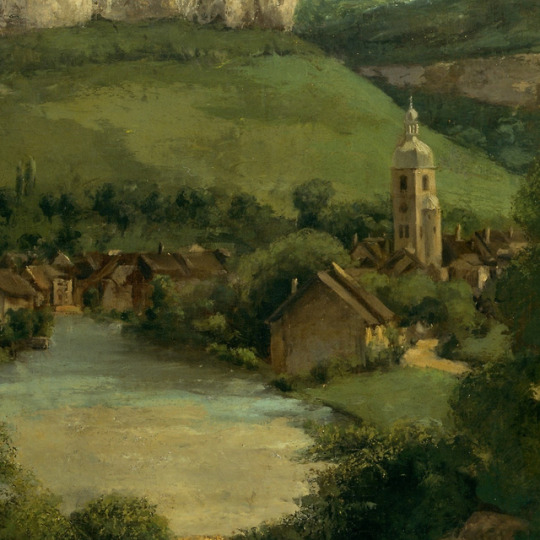

details of view of ornans (mid 1850) by gustave courbet (1819 – 1877)
#please please please tumblr dont f up the quality im begging you#anyways the boy the man courbet this one is for all the gays#kinda sad that we didnt have much time to study realism and only did burial at ornans by courbet and the third class carriage by daumier#ok if you excuse me im gonna tag the heck out of this#gustave courbet#19th century#realism#art history#historia del arte#realismo#can i tag as farmcore or not#ok im gonna but dont tell anybody#farmcore#cottagecore#naturecore#art details
24 notes
·
View notes
Text









1. Deep Breath, Dr Who // 2. The Burial At Ornans, Courbet // 3. Self Portrait with Fiddling Death, Bocklin // 4. Death and the Maiden, Stokes // 5. A Funeral, Ancher
I Don’t Think I Know Who You Are Anymore
#because it's always a ghost story for them - isn't it???#no matter how much love they hold for one another#one of them is always always going to be a ghost#separated by death while their hearts' are still beating and all of that nonsense#Doctor Who#Clara Oswald#12th Doctor#TwelveClara#whoffaldi
13 notes
·
View notes
Photo
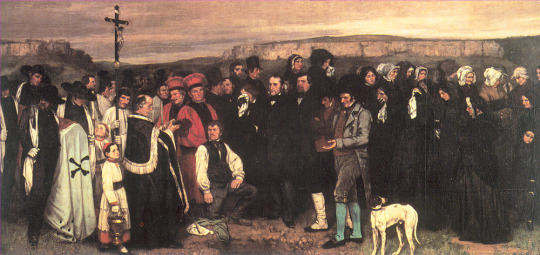
A Burial at Ornans, 1850, Gustave Courbet
Medium: oil,canvas
25 notes
·
View notes
Text
artist research/painting

Gustav Courbet ‘The Painters Studio’ - a rough interpretation.
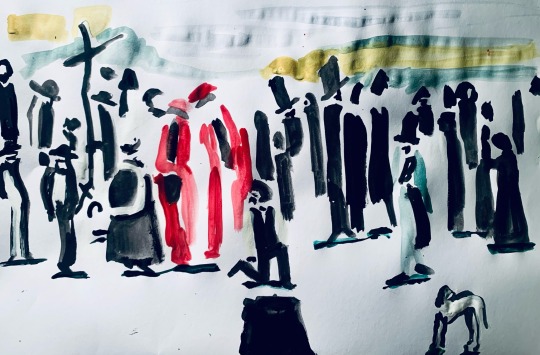
Burial at ornans
4 notes
·
View notes
Text

THE PAINTER'S STUDIO (1855) by GUSTAVE COURBET
This painting is a testament to COURBET’S love for himself and his pride in his strength of character, determination, perseverance and innovative genius. Much like he heroicized others in his BURIAL AT ORNANS, COURBET does the same in this painting.
With a good dose of selfishness, COURBET argues that things are accomplished and attitudes evolve when people think outside the box and challenge the norm. COURBET places himself full-size, brush in hand, working on a landscape painting.
His companions on the right are symbols of companionship and creativity, while the admiration of the boy is a symbol of COURBET’S assurance that his legacy will live on for generations to come. The nude model behind the artist symbolizes his magnificence and her role as his muse.
On the left, we see the working poor, symbolized by COURBET’S, acknowledgement of their right to be included. On the right, we see his rival, NAPOLEON III, depicted as a poacher with a gun in his hand, along with his pack of dogs. The chin-up stance of COURBET contrasts with Napoleon’s downward tilt of the head in a sign of the innovator triumphing over the dictator.
0 notes
Photo

https://www.metmuseum.org/toah/hd/gust/hd_gust.htm“Faith is by no means a mere act of choice, an option for a special solution to the problems of existence. It is birth to a higher life by obedience to the Source of Life: to believe is thus to consent to hear and to obey a creative command that raises us from the dead. And what can be a deeper motive for belief?
We believe, not because we want to know, but because we want to be.”
~ Thomas Merton
[The Source of the Lison, 1866 - Gustave Courbet]
• Thomas Merton (1915-1968) is arguably the most influential American Catholic author of the twentieth century. His autobiography, The Seven Storey Mountain, has sold over one million copies and has been translated into over fifteen languages. He wrote over sixty other books and hundreds of poems and articles on topics ranging from monastic spirituality to civil rights, nonviolence, and the nuclear arms race. More: http://merton.org/chrono.aspx
• Gustave Courbet created a sensation at the Paris Salon of 1850–51 when he exhibited a group of paintings set in his native Ornans, a village in the Franche-Comté in eastern France. These works, including The Stonebreakers (1849–50; now lost) and A Burial at Ornans (1849–50; Musèe d’Orsay, Paris) challenged convention by rendering scenes from daily life on the large scale previously reserved for history painting and in an emphatically realistic style. Confronted with the unvarnished realism of Courbet’s imagery, critics derided the ugliness of his figures and dismissed them as “peasants in their Sunday best.” More:
2 notes
·
View notes
